Permanent Deformation and Its Unified Model of Coal Gangue Subgrade Filler under Traffic Cyclic Loading
Abstract
:1. Introduction
2. Laboratory Testing Program
2.1. Tested Materials and Apparatus
2.2. Specimen Preparation and Testing Program
3. Permanent Deformation Analysis
3.1. Effect of Confining Pressure on the Permanent Deformation
3.2. Effect of Grading on the Permanent Deformation
3.3. Effect of Compaction Degree on the Permanent Deformation
4. Unified Model of Permanent Deformation
4.1. Comparative Analysis of Existing Models
4.2. Establishment of Unified Model for Permanent Deformation
4.3. Model Parameter Analysis
4.4. Model Validation
5. Conclusions
- (1)
- Experimental grading was designed by using FMGE, and the well-grading limits of CGSF were captured based on the FMGE, i.e., the grading is uniform when 1.89 ≤ ≤ 2.63.
- (2)
- The relationship curve between and N can be divided into three stages, i.e., the rapid growth phase, the deceleration growth phase, and the approaching stability phase. N = 1000 can be used as a criterion for reaching the stable stage of CGSF, which can guide the later test loading and coal gangue subgrade engineering.
- (3)
- The effect of confining pressure on is related to the level of confining pressure. The effect of confining pressure on is significant when the confining pressure is smaller, whereas the influence of confining pressure on is smaller when the confining pressure is larger.
- (4)
- The influence of grading on of coal gangue samples is significant. With the increase of , first increases and then decreases, reflecting that there is an obvious optimal grading for coal gangue samples under cyclic loading.
- (5)
- The effect of compaction degree on of CGSF depends on the level of compaction degree. is hardly affected when the compaction degree is smaller, whereas increasing compaction degree has a significant effect on restraining when the compaction degree is bigger.
- (6)
- According to the analysis of the permanent deformation curve for CGSF, the unified calculation model of permanent deformation for CGSF under cyclic loading was established. Compared with the existing permanent deformation models, the proposed model in this paper can better describe the permanent deformation of CGSF under cyclic loading. Then, the model parameters were analyzed and the model was verified.
Author Contributions
Funding
Data Availability Statement
Conflicts of Interest
References
- Zhang, Y.; Ling, T.-C. Reactivity activation of waste coal gangue and its impact on the properties of cement-based materials—A review. Constr. Build. Mater. 2020, 234, 117424. [Google Scholar] [CrossRef]
- Zhao, Y.; Qiu, J.; Ma, Z.; Sun, X. Eco-friendly treatment of coal gangue for its utilization as supplementary cementitious materials. J. Clean. Prod. 2021, 285, 124834. [Google Scholar] [CrossRef]
- Li, J.; Huang, Y.; Ouyang, S.; Guo, Y.; Gao, H.; Wu, L.; Shi, Y.; Zhu, L. Transparent characterization and quantitative analysis of broken gangue’s 3D fabric under the bearing compression. Int. J. Min. Sci. Technol. 2022, 32, 335–345. [Google Scholar] [CrossRef]
- Ma, D.; Duan, H.; Liu, J.; Li, X.; Zhou, Z. The role of gangue on the mitigation of mining-induced hazards and environmental pollution: An experimental investigation. Sci. Total Environ. 2019, 664, 436–448. [Google Scholar] [CrossRef] [PubMed]
- Chen, X.; Zheng, L.; Dong, X.; Jiang, C.; Wei, X. Sources and mixing of sulfate contamination in the water environment of a typical coal mining city, China: Evidence from stable isotope characteristics. Environ. Geochem. Health 2020, 42, 2865–2879. [Google Scholar] [CrossRef]
- Xiao, G.; Yang, G.; Jixi, C.; Ruyi, Z. Deterioration mechanism of coal gangue concrete under the coupling action of bending load and freeze–thaw. Constr. Build. Mater. 2022, 338, 127265. [Google Scholar] [CrossRef]
- Wu, Q.-h.; Weng, L.; Zhao, Y.-l.; Feng, F. Influence of infilling stiffness on mechanical and fracturing responses of hollow cylindrical sandstone under uniaxial compression tests. J. Cent. South Univ. 2021, 28, 2485–2498. [Google Scholar] [CrossRef]
- Wu, Q.; Weng, L.; Zhao, Y.; Zhao, F.; Peng, W.; Zhang, S. Deformation and cracking characteristics of ring-shaped granite with inclusion under diametrical compression. Arab. J. Geosci. 2020, 13, 681. [Google Scholar] [CrossRef]
- Li, Y.; Liu, S.; Guan, X. Multitechnique investigation of concrete with coal gangue. Constr. Build. Mater. 2021, 301, 124114. [Google Scholar] [CrossRef]
- Qiu, J.; Zhu, M.; Zhou, Y.; Guan, X. Effect and mechanism of coal gangue concrete modification by fly ash. Constr. Build. Mater. 2021, 294, 123563. [Google Scholar] [CrossRef]
- Zhao, B.; Zhai, D.; Xin, J.; Guo, Y.; Wang, J.; Wei, Q.; Wang, H.; Tang, R. Rheological properties, mechanical characteristics, and microstructures of gangue-cemented paste backfill: Linking to loess doses. Arab. J. Geosci. 2022, 15, 244. [Google Scholar] [CrossRef]
- Zhao, Y.; Yang, C.; Li, K.; Qu, F.; Yan, C.; Wu, Z. Toward understanding the activation and hydration mechanisms of composite activated coal gangue geopolymer. Constr. Build. Mater. 2022, 318, 125999. [Google Scholar] [CrossRef]
- Su, Z.; Li, X.; Zhang, Q. Influence of thermally activated coal gangue powder on the structure of the interfacial transition zone in concrete. J. Clean. Prod. 2022, 363, 132408. [Google Scholar] [CrossRef]
- Chen, M.; Wen, P.; Wang, C.; Chai, Z.; Gao, Z. Evaluation of particle size distribution and mechanical properties of mineral waste slag as filling material. Constr. Build. Mater. 2020, 253, 119183. [Google Scholar] [CrossRef]
- Li, J.; Zhang, J.; Yang, X.; Zhang, A.; Yu, M. Monte Carlo simulations of deformation behaviour of unbound granular materials based on a real aggregate library. Int. J. Pavement Eng. 2023, 24, 2165650. [Google Scholar] [CrossRef]
- Li, J.; Zhang, J.; Zhang, A.; Peng, J. Evaluation on Deformation Behavior of Granular Base Material during Repeated Load Triaxial Testing by Discrete-Element Method. Int. J. Geomech. 2022, 22, 04022210. [Google Scholar] [CrossRef]
- Yao, Y.; Li, J.; Ni, J.; Liang, C.; Zhang, A. Effects of gravel content and shape on shear behaviour of soil-rock mixture: Experiment and DEM modelling. Comput. Geotech. 2022, 141, 104476. [Google Scholar] [CrossRef]
- JTG 3430-2020; Test Methods of Soils for Highway Engineering. China Communications Press: Beijing, China, 2020. (In Chinese)
- Chen, W.B.; Yin, J.H.; Feng, W.Q.; Borana, L.; Chen, R.P. Accumulated Permanent Axial Strain of a Subgrade Fill under Cyclic High-Speed Railway Loading. Int. J. Geomech. 2018, 18, 04018018. [Google Scholar] [CrossRef]
- Cai, Y.Q.; Chen, J.Y.; Cao, Z.G.; Gu, C.; Wang, J. Influence of Grain Gradation on Permanent Strain of Unbound Granular Materials under Low Confining Pressure and High-Cycle Loading. Int. J. Geomech. 2018, 18, 04017156. [Google Scholar] [CrossRef]
- Leng, W.; Xiao, Y.; Nie, R.-s.; Zhou, W.; Liu, W. Investigating Strength and Deformation Characteristics of Heavy-Haul Railway Embankment Materials Using Large-Scale Undrained Cyclic Triaxial Tests. Int. J. Geomech. 2017, 17, 04017074. [Google Scholar] [CrossRef]
- Zhang, Z.-T.; Gao, W.-H. Effect of different test methods on the disintegration behaviour of soft rock and the evolution model of disintegration breakage under cyclic wetting and drying. Eng. Geol. 2020, 279, 105888. [Google Scholar] [CrossRef]
- Zhang, Z.-T.; Gao, W.-H.; Wang, X.; Zhang, J.-Q.; Tang, X.-Y. Degradation-induced evolution of particle roundness and its effect on the shear behaviour of railway ballast. Transp. Geotech. 2020, 24, 100388. [Google Scholar] [CrossRef]
- Zhang, Z.-T.; Gao, W.-H.; Zeng, C.-F.; Tang, X.-Y.; Wu, J. Evolution of the disintegration breakage of red-bed soft rock using a logistic regression model. Transp. Geotech. 2020, 24, 100382. [Google Scholar] [CrossRef]
- Zhu, J.G.; Guo, W.L.; Wen, Y.F.; Yin, J.H.; Zhou, C. New Gradation Equation and Applicability for Particle-Size Distributions of Various Soils. Int. J. Geomech. 2018, 18, 04017155. [Google Scholar] [CrossRef]
- Wu, E.L.; Zhu, J.G.; Chen, G.; Wang, L. Experimental study of effect of gradation on compaction properties of rockfill materials. Bull. Eng. Geol. Environ. 2020, 79, 2863–2869. [Google Scholar] [CrossRef]
- García-de-la-Oliva, J.L.; Moreno-Robles, J. Granular sub-ballast compaction control methods in high-speed railway lines. Spanish experience. Transp. Geotech. 2019, 19, 135–145. [Google Scholar] [CrossRef]
- Trinh, V.N.; Tang, A.M.; Cui, Y.-J.; Dupla, J.-C.; Canou, J.; Calon, N.; Lambert, L.; Robinet, A.; Schoen, O. Mechanical characterisation of the fouled ballast in ancient railway track substructure by large-scale triaxial tests. Soils Found. 2012, 52, 511–523. [Google Scholar] [CrossRef]
- Lenart, S.; Koseki, J.; Miyashita, Y.; Sato, T. Large-scale triaxial tests of dense gravel material at low confining pressures. Soils Found. 2014, 54, 45–55. [Google Scholar] [CrossRef] [Green Version]
- Wichtmann, T.; Rondón, H.A.; Niemunis, A.; Triantafyllidis, T.; Lizcano, A. Prediction of Permanent Deformations in Pavements Using a High-Cycle Accumulation Model. J. Geotech. Geoenviron. Eng. 2010, 136, 728–740. [Google Scholar] [CrossRef] [Green Version]
- Kong, X.; Liu, J.; Zou, D.; Liu, H. Stress-Dilatancy Relationship of Zipingpu Gravel under Cyclic Loading in Triaxial Stress States. Int. J. Geomech. 2016, 16, 04016001. [Google Scholar] [CrossRef]
- Chen, G.; Wu, Q.; Zhao, K.; Shen, Z.; Yang, J. A Binary Packing Material–Based Procedure for Evaluating Soil Liquefaction Triggering during Earthquakes. J. Geotech. Geoenviron. Eng. 2020, 146, 04020040. [Google Scholar] [CrossRef]
- Wu, Q.; Ma, W.j.; Liu, Q.; Zhao, K.; Chen, G. Dynamic shear modulus and damping ratio of rubber-sand mixtures with a wide range of rubber content. Mater. Today Commun. 2021, 27, 102341. [Google Scholar] [CrossRef]
- Huang, B.; Ding, H.; Chen, Y. Simulation of high-speed train load by dynamic triaxial tests. Chin. J. Geotech. Eng. 2011, 33, 195–202. (In Chinese) [Google Scholar]
- Li, Y.; Zhang, J.; Zhu, Z.; Wang, X.; Yu, Z. Accumulated deformation of gravel filler of subgrade under cyclic loading. Adv. Eng. Sci. 2018, 50, 130–137. (In Chinese) [Google Scholar]
- Wang, C.; Chen, Y. Study on effect of traffic loading induced static deviator stress on undrained cyclic properties of saturated soft clay. Chin. J. Geotech. Eng. 2007, 29, 1742–1747. (In Chinese) [Google Scholar]
- Wang, J.; Chang, Z.; Tang, Y.; Tang, Y. Dynamic triaxial test analysis of reinforced gravel soil under cyclic loading. Rock Soil Mech. 2020, 41, 2851–2860. (In Chinese) [Google Scholar]
- Wu, E.; Zhu, J.; Guo, W.; Zhang, Z. Effect of Gradation on the Compactability of Coarse-Grained Soils. KSCE J. Civ. Eng. 2020, 24, 356–364. [Google Scholar] [CrossRef]
- Zhang, Z.; Gao, W.; Liu, C.; Liu, Z.; Feng, X. Experimental study on the effect of gradation on the compaction and strength characteristics of coal gangue subgrade filler. J. Eng. Geol. 2022. (In Chinese) [Google Scholar] [CrossRef]
- Monismith, C.L.; Ogawa, N.; Freeme, C.R. Permanent deformation characteristics of subgrade soils due to repeated load. Transp. Res. Rec. 1975, 537, 1–17. [Google Scholar]
- Liu, B.; Pham, D.P.; Su, Q.; Gui, B. Deformation characteristics of subgrade graded gravel with different water contents. Rock Soil Mech. 2016, 37, 1365–1372. (In Chinese) [Google Scholar]
- Mu, R.; Huang, Z.; Pu, S.; Yao, Z.; Cheng, X. Accumulated deformation characteristics of undisturbed red clay under cyclic loading and dynamic constitutive relationship. Rock Soil Mech 2020, S2, 1–10. (In Chinese) [Google Scholar]
- Mei, H.; Leng, W.; Nie, R.; Li, Y. Study on dynamic behavior and permanent deformation characteristics of coarse-grained soil. J. Huazhong Univ. of Sci. Technol. (Nat. Sci. Ed.) 2019, 47, 113–119. (In Chinese) [Google Scholar]
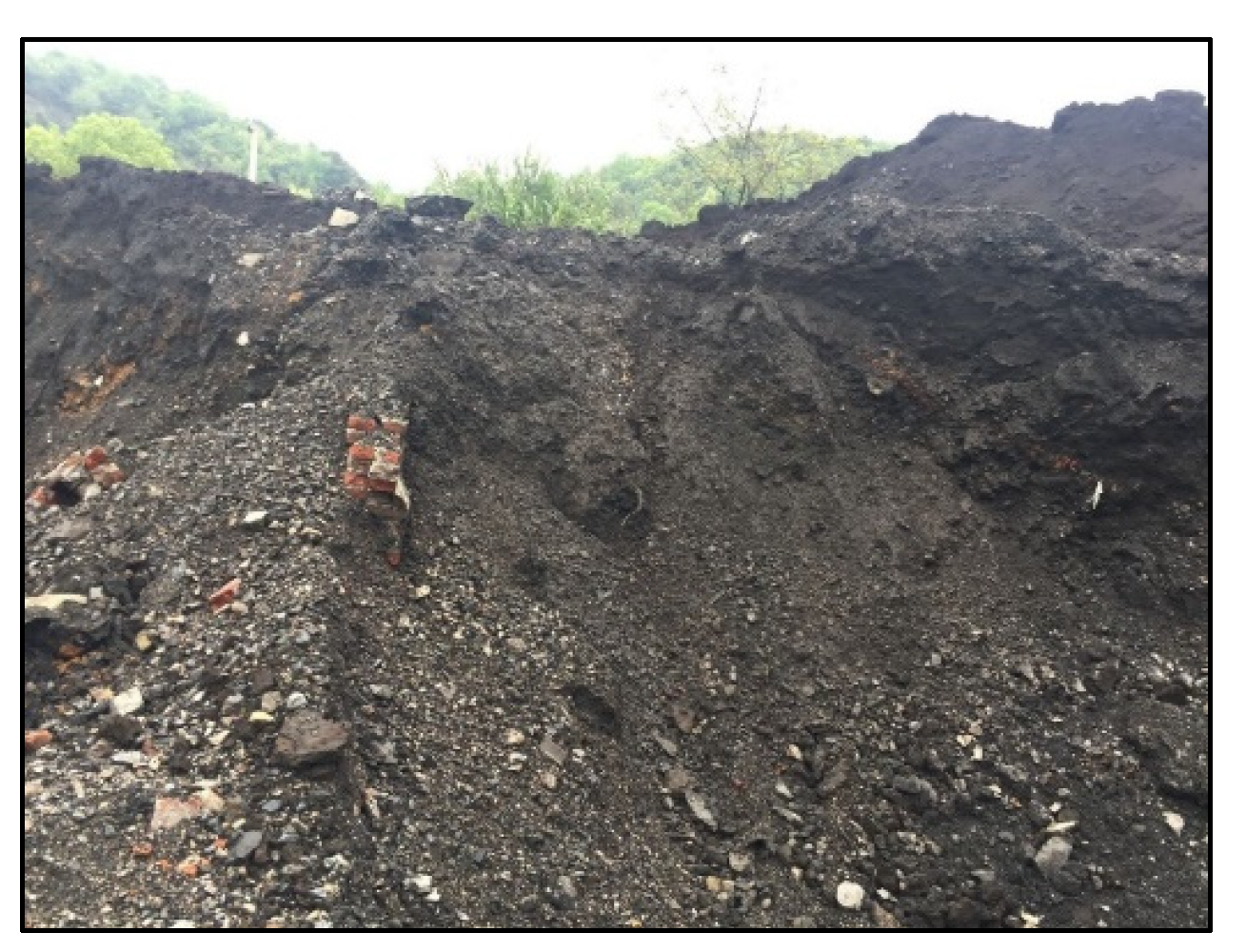

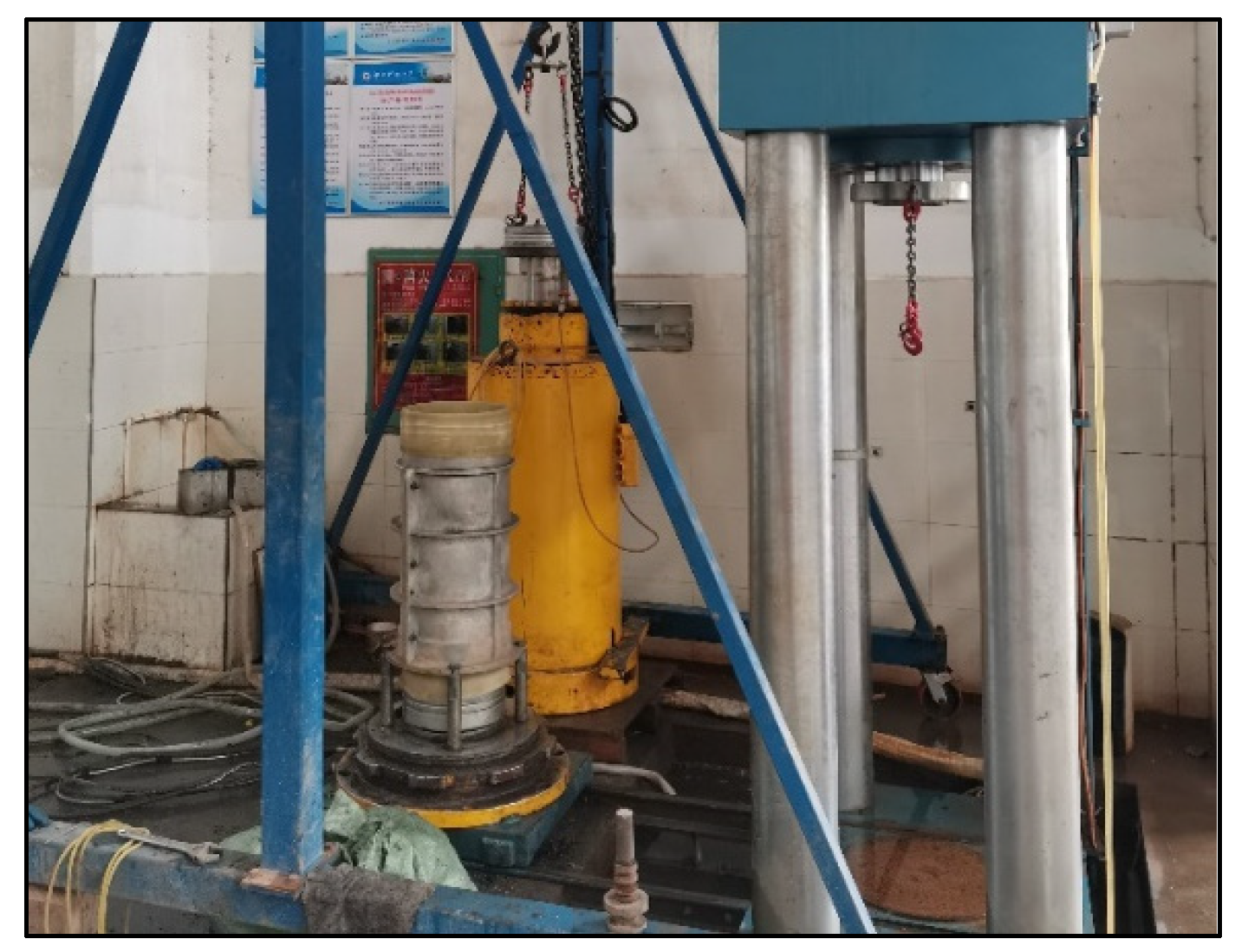
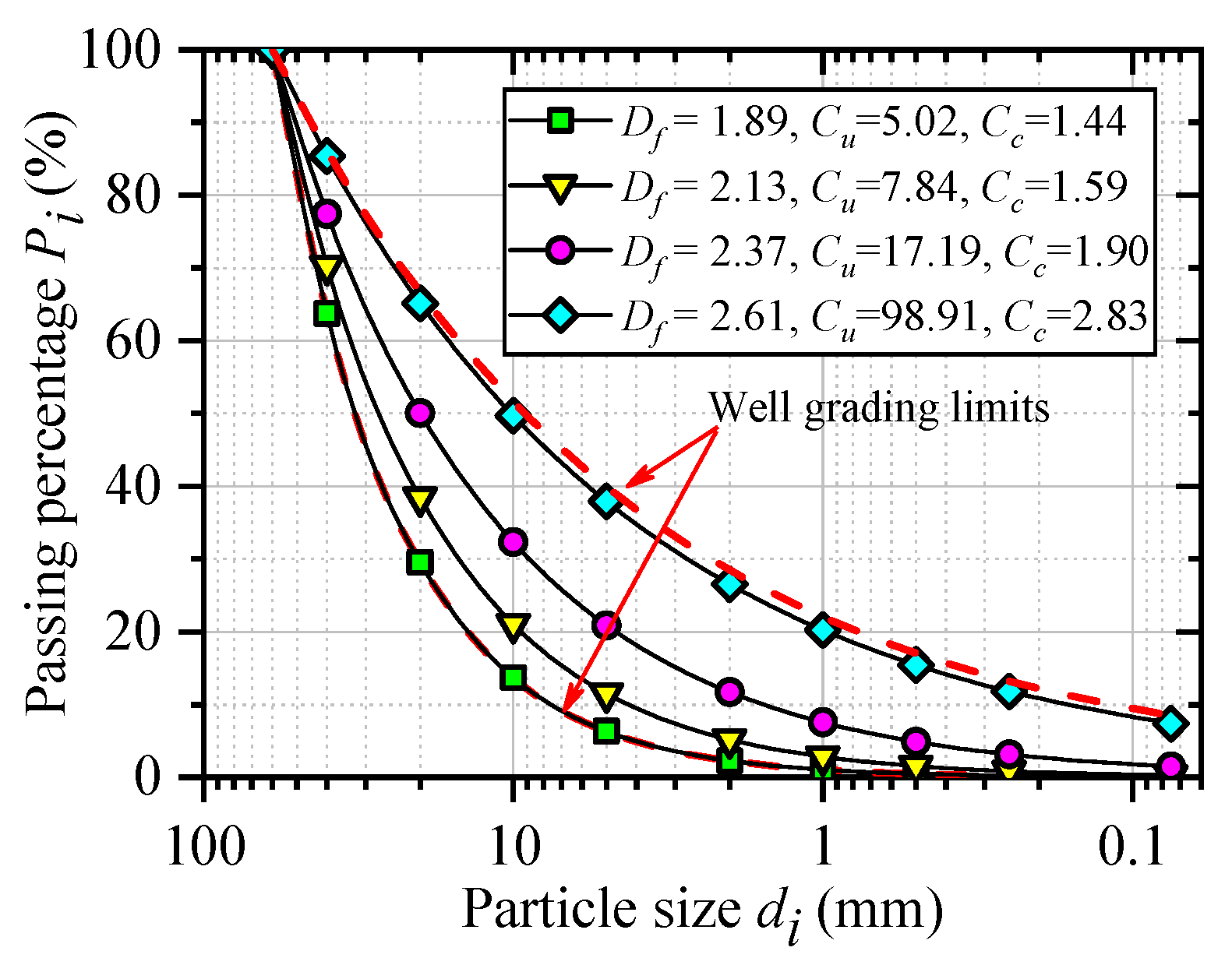
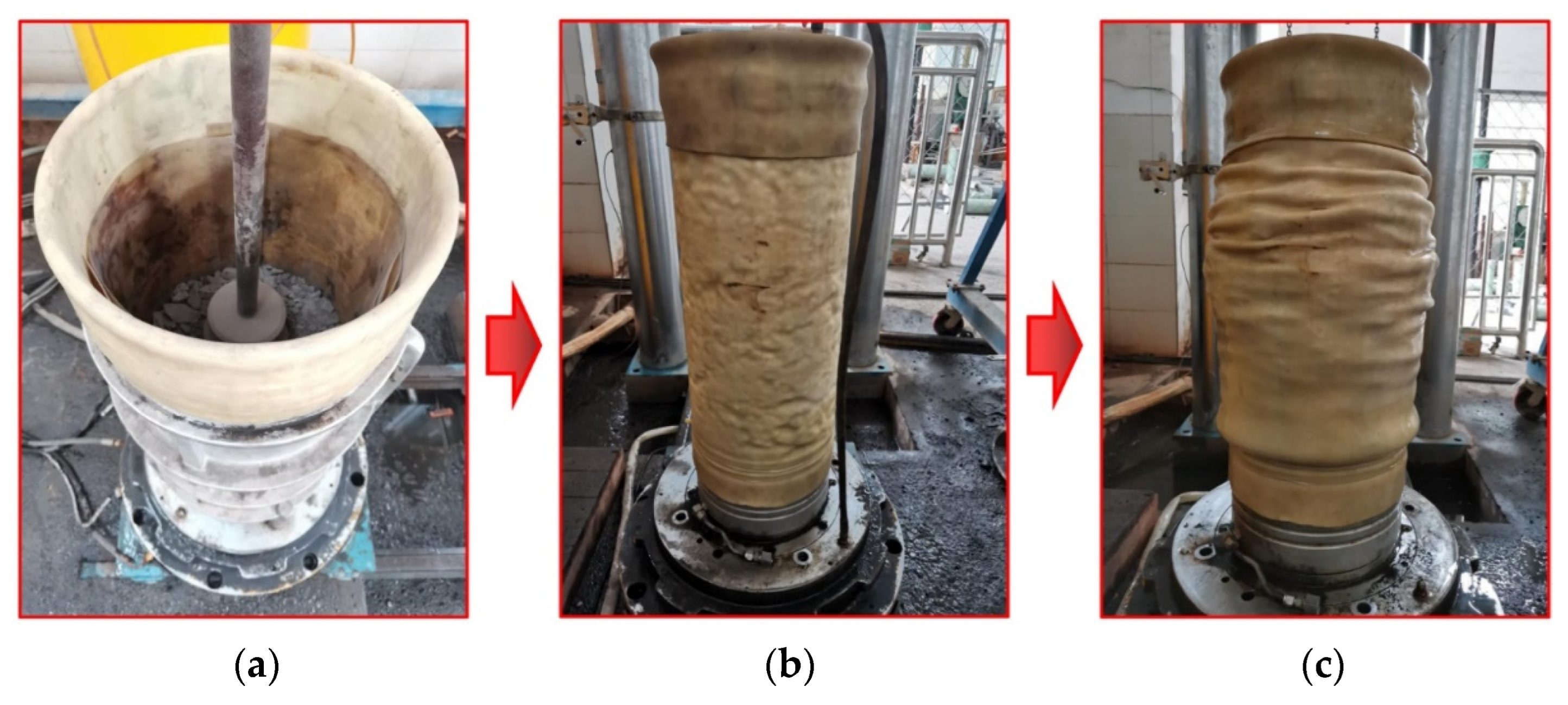
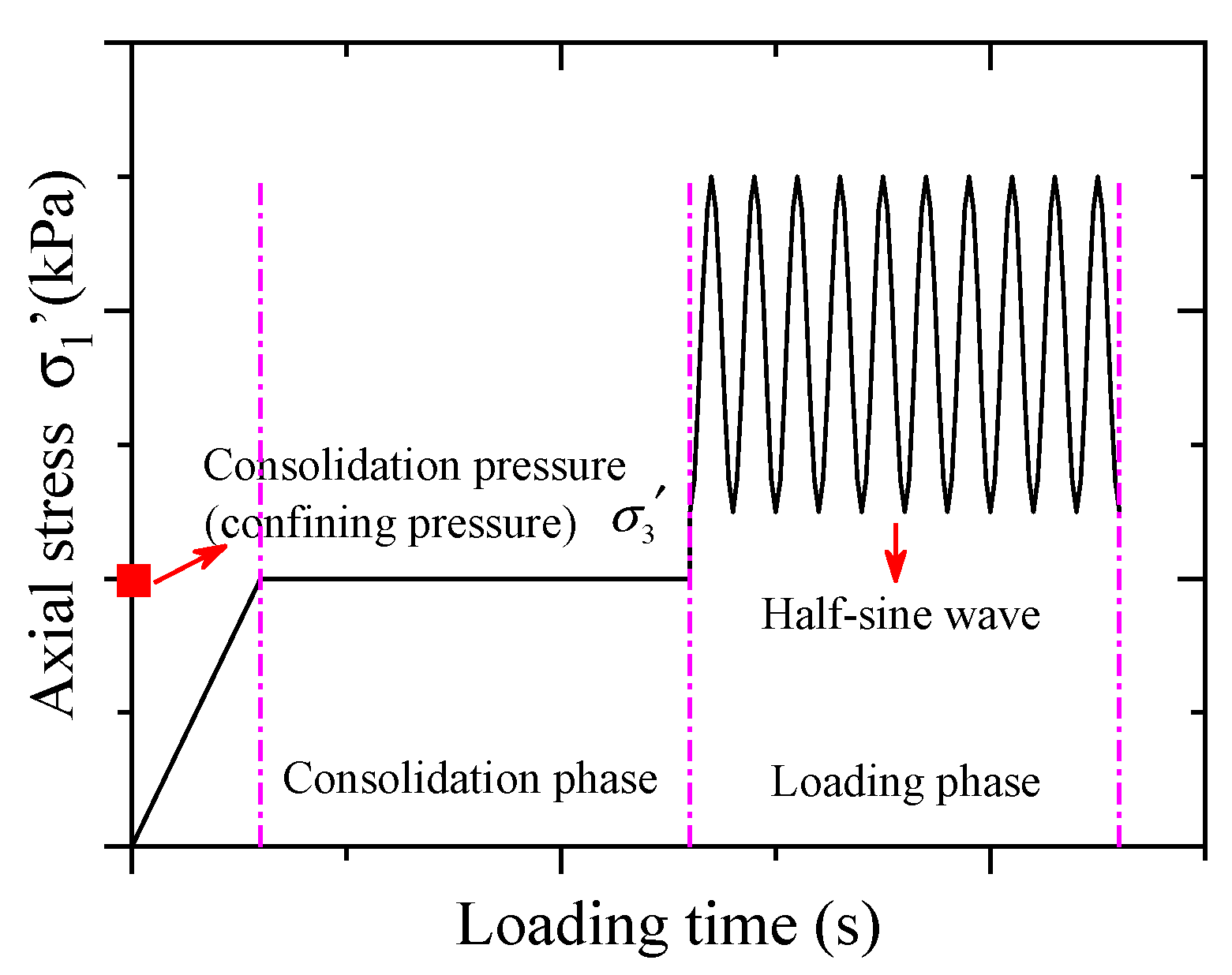
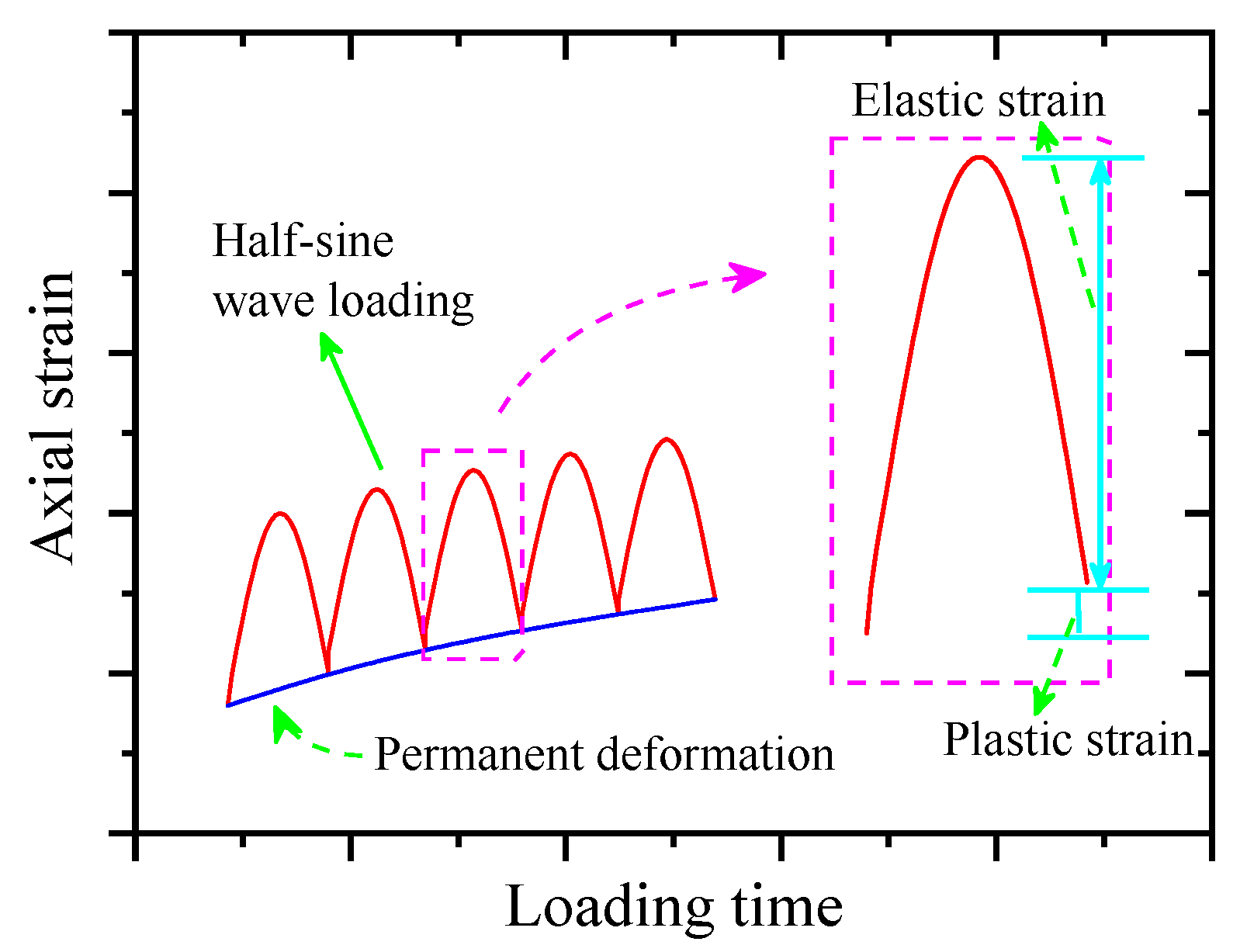
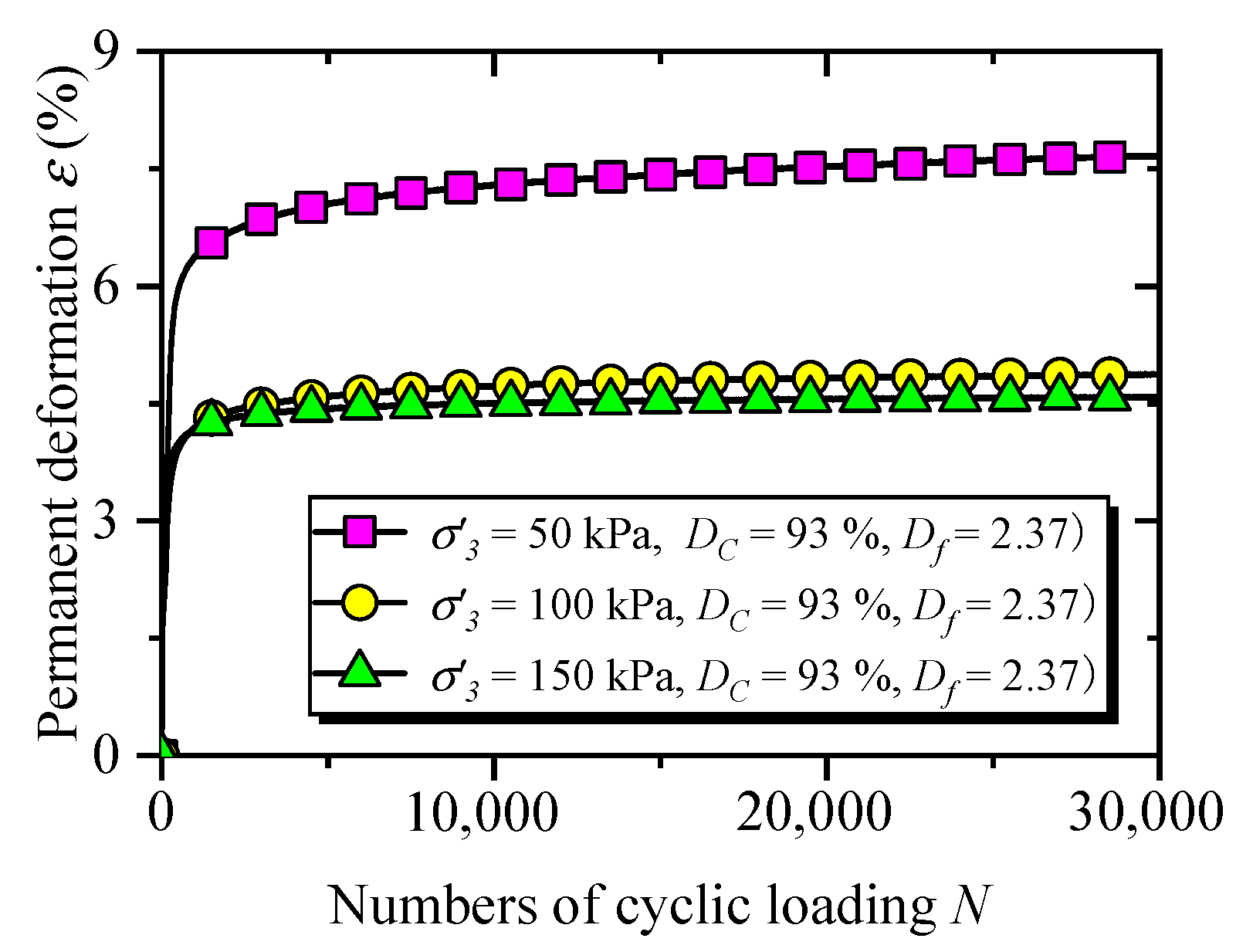


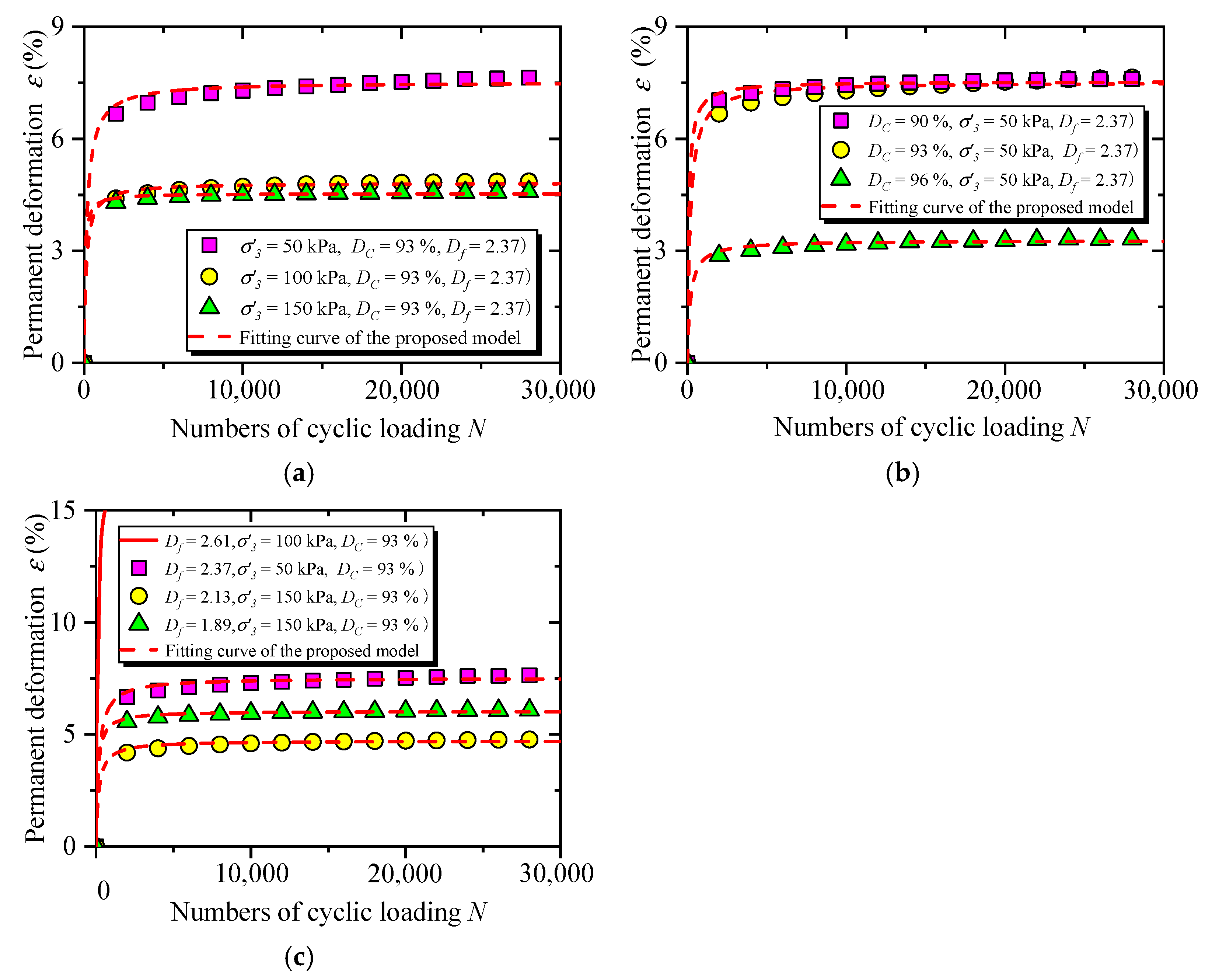
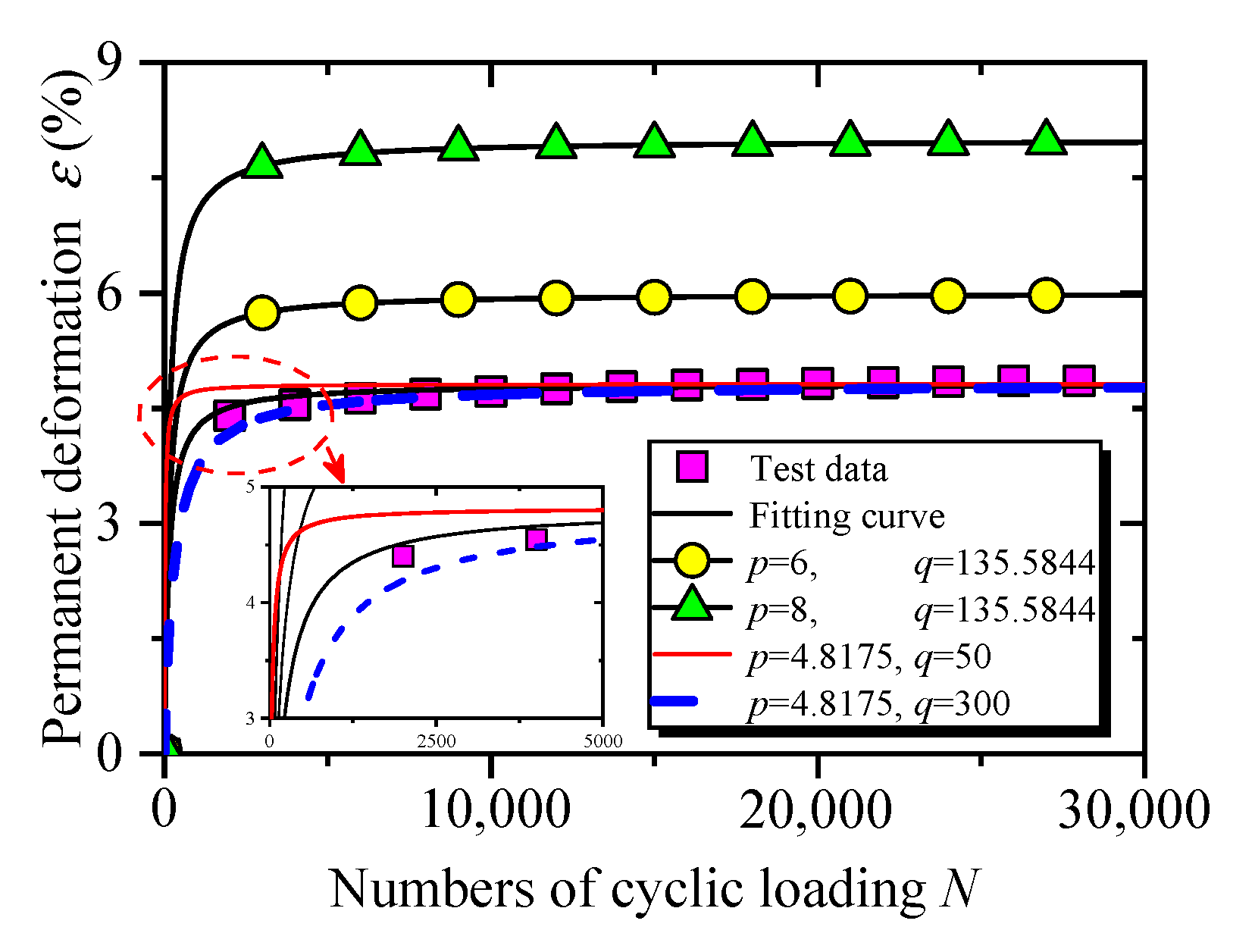
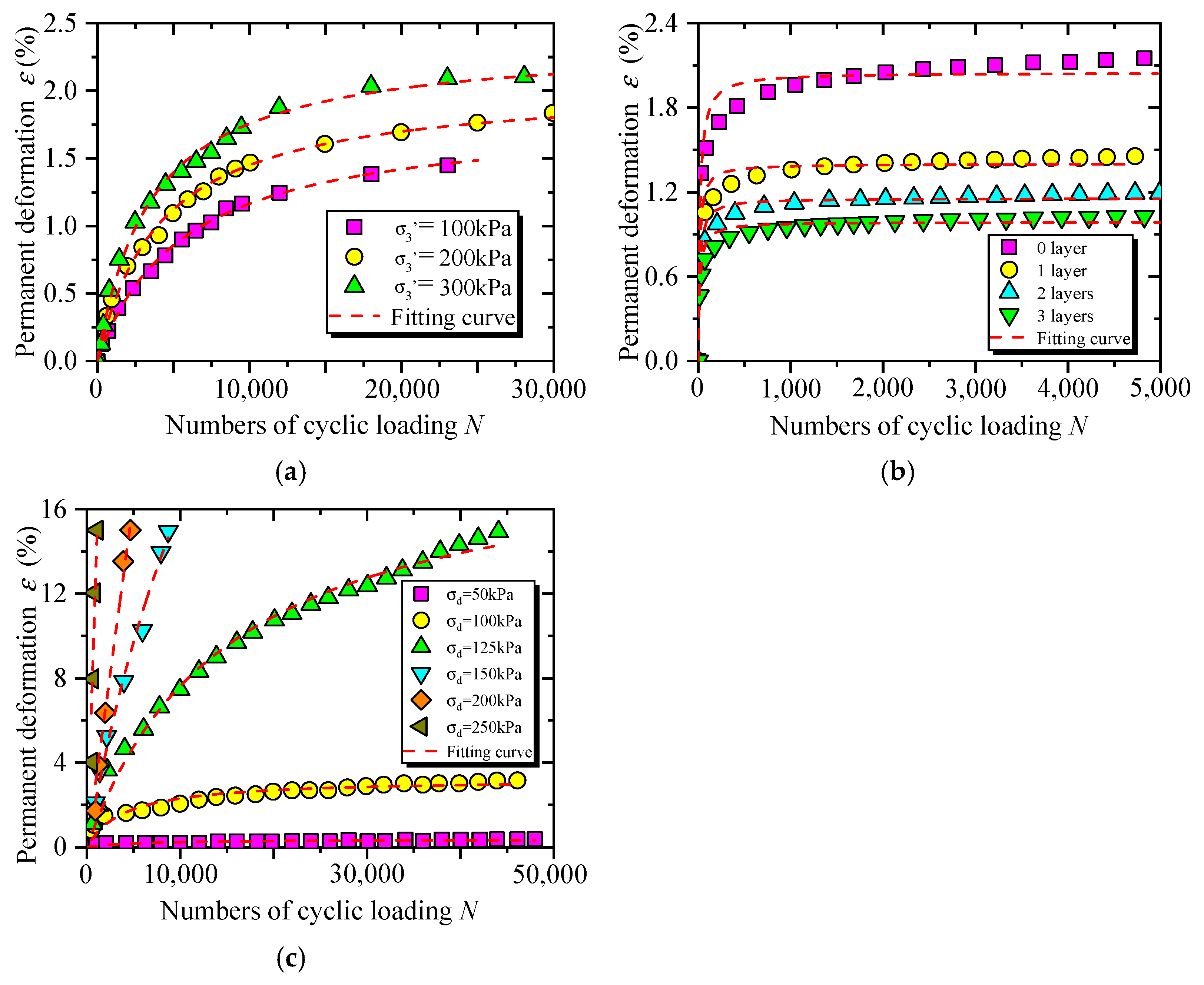
| Specimen Number | (%) | ||
|---|---|---|---|
| DT01 | 2.37 | 50 | 93 |
| DT02 | 2.37 | 100 | 93 |
| DT03 | 2.37 | 150 | 93 |
| DT04 | 2.37 | 50 | 90 |
| DT05 | 2.37 | 50 | 96 |
| DT06 | 2.61 | 50 | 93 |
| DT07 | 2.13 | 50 | 93 |
| DT08 | 1.89 | 50 | 93 |
| Specimen Number | DT01 | DT02 | DT03 | DT04 | DT05 | DT06 | DT07 | DT08 |
|---|---|---|---|---|---|---|---|---|
| 3.9085 | 2.8126 | 3.2501 | 4.9523 | 1.6604 | 12.1707 | 2.5312 | 3.7737 | |
| 0.0667 | 0.0550 | 0.0345 | 0.0432 | 0.0693 | 0.0323 | 0.0635 | 0.0482 | |
| 0.8159 | 0.7709 | 0.7050 | 0.7170 | 0.8585 | 0.3876 | 0.8570 | 0.7742 | |
| 7.3600 | 4.7367 | 4.4983 | 7.4476 | 3.2039 | 16.5600 | 4.6217 | 5.9533 | |
| 0.0033 | 0.0041 | 0.0102 | 0.0062 | 0.0031 | 0.0051 | 0.0033 | 0.0047 | |
| 0.6947 | 0.7091 | 0.5936 | 0.7042 | 0.6320 | 0.8911 | 0.6038 | 0.6182 | |
| 2.8128 | 2.2945 | 3.0339 | 4.4157 | 1.1584 | 11.2994 | 1.9108 | 3.2612 | |
| 0.4808 | 0.2584 | 0.1558 | 0.3216 | 0.2163 | 0.5537 | 0.2866 | 0.2850 | |
| 0.8560 | 0.8095 | 0.7321 | 0.7494 | 0.8980 | 0.4149 | 0.8937 | 0.8091 |
| Specimen Number | DT01 | DT02 | DT03 | DT04 | DT05 | DT06 | DT07 | DT08 |
|---|---|---|---|---|---|---|---|---|
| 7.5179 | 4.8175 | 4.5371 | 7.5381 | 3.2774 | 16.7341 | 4.7171 | 6.0390 | |
| 178.5503 | 135.5844 | 55.5003 | 87.8797 | 193.5777 | 84.8601 | 172.0490 | 111.6893 | |
| 0.9165 | 0.9391 | 0.9031 | 0.9279 | 0.9104 | 0.9675 | 0.9034 | 0.9152 |
Disclaimer/Publisher’s Note: The statements, opinions and data contained in all publications are solely those of the individual author(s) and contributor(s) and not of MDPI and/or the editor(s). MDPI and/or the editor(s) disclaim responsibility for any injury to people or property resulting from any ideas, methods, instructions or products referred to in the content. |
© 2023 by the authors. Licensee MDPI, Basel, Switzerland. This article is an open access article distributed under the terms and conditions of the Creative Commons Attribution (CC BY) license (https://creativecommons.org/licenses/by/4.0/).
Share and Cite
Zhang, Z.-T.; Wang, Y.-H.; Gao, W.-H.; Hu, W.; Liu, S.-K. Permanent Deformation and Its Unified Model of Coal Gangue Subgrade Filler under Traffic Cyclic Loading. Appl. Sci. 2023, 13, 4128. https://doi.org/10.3390/app13074128
Zhang Z-T, Wang Y-H, Gao W-H, Hu W, Liu S-K. Permanent Deformation and Its Unified Model of Coal Gangue Subgrade Filler under Traffic Cyclic Loading. Applied Sciences. 2023; 13(7):4128. https://doi.org/10.3390/app13074128
Chicago/Turabian StyleZhang, Zong-Tang, Yan-Hao Wang, Wen-Hua Gao, Wei Hu, and Shun-Kai Liu. 2023. "Permanent Deformation and Its Unified Model of Coal Gangue Subgrade Filler under Traffic Cyclic Loading" Applied Sciences 13, no. 7: 4128. https://doi.org/10.3390/app13074128







